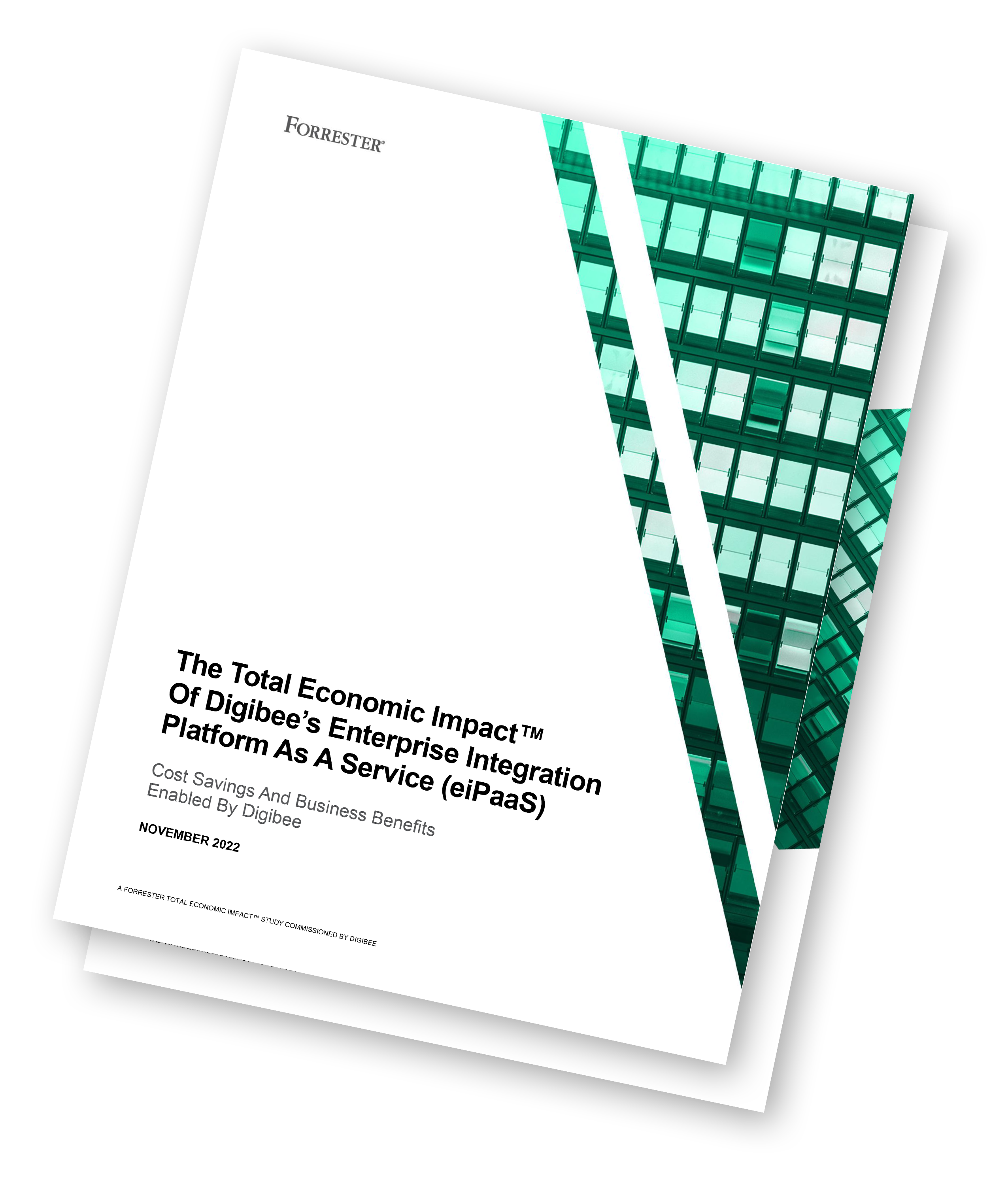February 14, 2023
Em um contrato recente com a Forrester Consulting, pedimos aos especialistas que colocassem números concretos por trás do valor que a Digibee oferece aos nossos clientes. O resultado? O relatório Total Economic Impact™ Of Digibee’s Integration Platform as a Service (eiPaaS)1, um exame detalhado que quantifica o lado positivo da tecnologia eiPaaS da Digibee.
Para contextualizar a pesquisa, a Forrester realizou entrevistas com clientes Digibee existentes, pegando o que eles aprenderam e usando para criar um cliente composto: uma organização de serviços financeiros que chamaremos de FinCo. Esta postagem de blog explora em detalhes o impacto econômico total proporcionado à FinCo após a implementação do Digibee.

O valor da integração empresarial
A integração empresarial significa muitas coisas para muitos setores diferentes. Para a fabricação, a conexão de sistemas e dados diferentes fornece uma visão abrangente da operação para supervisão em tempo real, o que, por sua vez, otimiza a produtividade e o tempo de lançamento no mercado.
No varejo, a integração empresarial permite uma infraestrutura de tecnologia combinável, permitindo que o varejista adote rapidamente novas inovações que suportam e aprimoram as experiências digitais do cliente.
In serviços financeiros (FiServ), a integração corporativa suporta a evolução do negócio, especialmente importante em um setor onde a infraestrutura legada é muitas vezes um obstáculo ao progresso. Ao conectar o antigo com o novo, uma organização FiServ pode facilmente manter o ritmo e, muitas vezes, liderar dentro de seu espaço de mercado.
Ao contrário de outras indústrias, o cenário regulatório para FiServ é especialmente complicado. Por exemplo, nos EUA – e dependendo do tipo de FiServ – a empresa pode precisar fornecer supervisão dedicada em relação à lavagem de dinheiro (AML), conhecer seu cliente (KYC), conhecer seu negócio (KYB) e outras regras .
Considerações adicionais incluem segurança de aplicativos e dados, sendo a empresa responsável pela redução de riscos associados ao ciclo de vida de desenvolvimento de software (SDLC), gerenciamento de dados, tratamento de acesso, gerenciamento de patches e outros. Essas questões tornam-se ainda mais complicadas quando você inclui o gerenciamento de riscos de terceiros que se estende a provedores de serviços, parceiros e outros relacionamentos estratégicos.
Acompanhar tantas peças em movimento é extremamente difícil. Fazer isso em tempo real para garantir uma resposta em tempo real requer um nível de conectividade que a integração empresarial pode suportar facilmente.
Perfil da Empresa FinCo
O cliente composto apresentado na análise de impacto econômico independente – FinCo – é uma empresa global de serviços financeiros. A organização oferece suporte a dois modelos diferentes: B2B e B2C, fornecendo vendas, serviços e suporte a milhões de clientes corporativos e consumidores.
Com uma marca forte e operações globais, o negócio emprega 20,000 pessoas e gera uma receita anual de US$ 5 bilhões.
Antes da Digibee, a estratégia de integração existente da FinCo dependia de soluções ponto a ponto que usavam código personalizado. O trabalho foi apoiado por seis desenvolvedores (FTEs) que gastaram 50% de seu tempo construindo e mantendo integrações.
Desafios de Integração da FinCo
O modelo de integração ponto a ponto era complicado e apresentava vários desafios comuns:
- Prazos de entrega de projetos perdidos
- Incapacidade de gerenciar integrações complexas
- Os volumes de transações excederam as capacidades do sistema interno
Para resolver esses desafios, a FinCo precisava aumentar a capacidade para concluir mais integrações em um ritmo mais rápido. Em vez de uma solução DIY ponto a ponto, a empresa queria empregar uma estratégia de integração moderna para poder lidar com integrações complexas com mais facilidade. A FinCo também queria aproveitar a flexibilidade de uma plataforma de integração baseada em nuvem versus uma solução local.
Impacto econômico total com Digibee
A Forrester Consulting quantificou o valor da Digibee para a FinCo com base em uma série de benefícios:
- Eficiência do desenvolvedor: construção e manutenção de integrações
- Poupança de custos: redução na mão de obra de TI, contratação de desenvolvedores menos experientes
- Eficiências de usuários de negócios internos
- Receita de tempo mais rápido para o mercado com novos produtos e serviços
Depois que o Digibee foi implementado, a FinCo obteve retornos imediatos. Por exemplo, aumentou eficiência do desenvolvedor. Antes da Digibee, o número de horas que a FinCo gastava construindo uma única integração era em média de 886 horas. No ano 1 com Digibee, isso diminuiu 50% para 443 horas. Nos anos 2 e 3, a média caiu ainda mais para 222 horas, para um aumento geral de eficiência de 75% em relação à solução ponto a ponto herdada.
No geral, a FinCo obteve economias significativas, eficiências operacionais e reduções de custo de TI com Digibee:
ROI: 232%
Retorno do investimento (ROI): Retorno esperado em termos percentuais. Calculado pela divisão dos benefícios líquidos (benefícios menos custos) pelos custos.
PV de benefícios: US$ 5.94 milhões
Valor Presente (PV): Valor presente ou atual das estimativas de custo e benefício dadas a uma taxa de juros.
VPL: US$ 415 milhões
Valor Presente Líquido (VPL): Valor presente ou atual dos fluxos de caixa líquidos futuros (descontados) dada uma taxa de juros (a taxa de desconto).
Retorno: <6 meses
Período de Reembolso: O ponto de equilíbrio para um investimento. Este é o ponto no tempo em que os benefícios líquidos (benefícios menos custos) se igualam ao investimento ou custo inicial.
iPaaS empresarial da Digibee para finanças
Conforme detalhado no estudo da Forrester, a plataforma de integração empresarial da Digibee aumenta a produtividade (construção e manutenção) de desenvolvedores e profissionais de TI. O low-code A plataforma Digibee permite que desenvolvedores juniores façam o trabalho anteriormente relegado a desenvolvedores seniores.
A Digibee agiliza e reduz o custo de todo o processo de desenvolvimento e, juntamente com um modelo de entrega de capacitação líder do setor, configura os clientes para adotar um eiPaaS de forma autônoma e fácil.
Para obter mais informações, leia o relatório O Impacto Econômico Total da Plataforma de Integração como Serviço (eiPaaS) da Digibee ou entre em contato conosco para obter um demonstração do Digibee eiPaaS.
1 Um estudo encomendado conduzido pela Forrester Consulting em nome da Digibee









